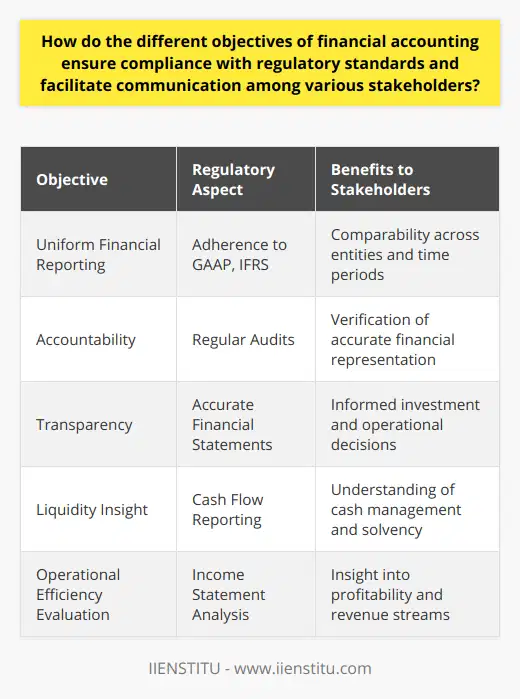
Financial accounting objectives are to keep track of the financial activities and make sure that they continue to operate in a manner which benefits all parties involved. There are three primary objectives including equity, usefulness, and comparability. Equity means that the information reported is accurate and reliable. Usability includes accessibility to all involved parties as well as timeliness of the reporting process. Comparability pertains to the ability for users to analyze different companies' data with their own data.
The first objective is equity meaning that the transactions that go into a company's financial reports need to be accurate and complete so there can be an unbiased representation of what really happened during operations. In order for this type of accounting system to work, it needs to have transparency throughout all the transactions and processes, which is why it is imperative that they are conducted fairly.
The second objective is usefulness to all parties who would potentially be affected by the company's financial statements. There needs to be a way of presenting the information so that anyone with access can interpret and analyze it regardless of what background or education they have obtained. It should not matter whether it is a professional accountant, an investor or even someone completely uninvolved in the company's daily business activities. This also goes along with the equity purpose because if no one can understand what is going on within a certain company, than there really isn't much point in having this type of reporting system set up since everyone would just assume it was inaccurate and therefore not trustworthy at all.
The last objective includes comparability among other companies within the same industry. This benchmarking process enables any financial statements to be comparable with other companies in order to make a better decision when deciding which one would be optimal for further operations or possible acquisition. For instance, if there were three similar retail clothing stores that all had different prices on the same products, then a comparison between those differences could help an interested customer decide which store has lower prices which would result in more sales overall for those involved. In order to have accurate comparisons, it needs to include information about how a company does business since this directly impacts the decisions they make and therefore their particular situation resulting in different types of transactions and reporting methods being put into place.
These are some of the primary financial accounting objectives that need to be met in order for a company to have a successful and beneficial financial reporting system. It is not an easy task by any means, but it is necessary in order to keep everyone on track and informed about what is happening within the company.
Accounting for assets
Liabilities, and owner's equity are the three primary financial statements in accounting. The statement of cash flows shows how the cash changed during the period. Financial accounting is important to companies because it provides information that is useful to management in making decisions about where to allocate resources, whether to borrow money or issue stock, and how well a company is doing financially.
Financial accounting is also important to outside parties such as investors, creditors, and tax authorities who need accurate information to make informed decisions about investing in a company, lending money to a company, or assessing what tax a company owes.
The objectives of financial accounting are: (1) accuracy and completeness so that financial statements present an unbiased view of a company's financial position; (2) usefulness so that all parties can use financial statements to make informed decisions; and (3) comparability such that companies may be compared with each other.
Accounting for liabilities
What is a liability? A liability is an obligation of a company to pay money or otherwise provide value to someone in the future. For example, a company may have to repay a loan from a bank, or might have to pay damages if it is sued. Liabilities are reported on a company's balance sheet.
Why is it important to account for liabilities? Accounting for liabilities is important because it helps companies track their financial position and make informed decisions about their business. Knowing how much money a company owes can help it make decisions about whether to borrow more money, take on new projects, or pay dividends to shareholders.
Are there different types of liabilities?
Yes, there are many different types of liabilities. Some of the most common include:
Accounts payable: This is money that a company owes to suppliers, contractors, and other businesses.
Bonds payable: This is money that a company owes to bondholders, usually in the form of regular interest payments and the return of the principal amount invested.
Income taxes payable: This is the amount of income tax that a company expects to owe for the current year.
Deferred income taxes: This is an estimate of how much income tax a company will owe in future years, based on its current liabilities and assets.
Unearned revenue: This is money that a company has received from customers but has not yet earned by providing goods or services. It is recorded as a liability until the company has earned it.
How is liability accounting different from other types of accounting?
Liability accounting is different from other types of accounting in two ways. First, liabilities are always reported on a company's balance sheet. Other assets and liabilities, such as revenue and expenses, are only reported when they are actually earned or incurred. Second, liabilities are always recorded at their present value. This means that the future payments that a company expects to make are discounted to account for the time value of money. For example, if a company expects to pay $1,000 in one year's time, it would record a liability of $950 today (assuming a 5% discount rate). This is done to give companies a fair idea of their position today.
An asset is anything that provides benefit to the company in the form of future economic benefit or a reduction in cost. Assets are usually purchased from cash reserves or from creditors where money is converted into something with future value for the company and thus providing them with a future economic gain or saving them cash in some way. Assets can also be created internally within the business if it uses resources such as raw materials e.g., wood, fabrics etc., to create beneficial outcomes for the business such as furniture and clothing which can then be sold on to generate income for the business rather than being simply thrown away in landfill.
Accounting for equity
The equity section encompasses all of the company's assets minus its liabilities. The net worth of a company is called shareholder equity or stockholders' equity. This is an important factor in determining how much money you're making on your investments, but it does require that you have accurate records of what your assets are and how much they are worth. Without knowing these figures, there's no way for any investor to know whether their returns are positive or negative over time.
Often times, the calculation only includes the common stock shares outstanding, not all of the preferred shares as well since those are more difficult to value correctly due to complicated factors such as dividends paid over time and redeemable rights at face value. If both types of stocks are listed on an exchange and can be traded, then their net worths need to be counted and included in the calculation.
Often times, there are special accounting rules for private companies. This means having a different method of arriving at equity calculations for businesses that have not issued shares or have instead issued debt instruments such as bonds or preferred stocks. In the case of private companies, it is generally accepted that you take your assets minus liabilities and subtract any intangible assets from that number. Intangible assets might include good will, patents or trademarks among other items with no physical value except the right to use them for a set amount of time. There are often different ways to calculate this area if an investor is trying to value a company in which he holds shares but isn't sure what the value of his assets or liabilities might be.
For instance, if you hold shares privately in a company and want to calculate equity, you can sometimes take all your assets and add them together for a total. To this total, add the current market value of all your liabilities and then subtract that number from your assets totaling. You also need to consider that there may be changes over time to how you calculate these figures. For instance, intangible assets such as patents lose some portion of their worth each year until they're completely expended at which point they no longer contribute anything to the business's net worth. In general though, once an asset has been fully depreciated it will not ever restore its value regardless of any changes in property values or other factors.
This is why equity calculations are so important to understand. They give a snapshot of a company's financial well-being at a given point and let you know whether it is making money or losing money. This information can help you decide whether to continue investing in the company or look for other opportunities.
As an investor, you need to be comfortable with the numbers behind the company you're considering investing in. Equity calculations provide all of the relevant data in one easy-to-read spot, so make sure you understand what they mean before diving in. With this knowledge in hand, you can feel more confident about the decisions you make when it comes to your money.
The equity section encompasses all of the company's assets minus its liabilities. The net worth of a company is called shareholder equity or stockholders' equity. This is an important factor in determining how much money you're making on your investments, but it does require that you have accurate records of what your assets are and how much they are worth. Without knowing these figures, there's no way for any investor to know whether their returns are positive or negative over time.
Often times, the calculation only includes the common stock shares outstanding, not all of the preferred shares as well since those are more difficult to value correctly due to complicated factors such as dividends paid over time and redeemable rights at face value. If both types of stocks are listed on an exchange and can be traded, then their net worths need to be counted and included in the calculation.
This is why getting a good understanding of equity calculations is so important for anyone interested in investing. It lets you see how well the company is doing financially at a glance and can help you make more informed decisions about where to put your money. With this knowledge, you can feel more confident that you're making good choices when it comes to your finances.
Recording transactions in the journal
When it comes to bookkeeping, one of the most important steps is recording transactions in the journal. This helps you keep track of your finances on a day-to-day basis, and can make it much easier to stay organized and understand what's going on with your business' money.
There are a number of ways to record transactions in a journal, and the method you choose will largely depend on your own personal preferences and style of bookkeeping. Some people prefer to simply write down the date, amount, and description of each transaction as it happens; others like to create detailed spreadsheets with formulas and charts to track their income and expenses.
No matter which method you choose, the most important thing is to be consistent and to update your journal regularly. This will help you stay on top of your business' finances and make it easier to spot any potential problems or areas where you may be able to save money.
So, start recording your transactions today and see how much of a difference it makes in your bookkeeping! You'll be glad you did.
Double-entry accounting
Double-entry accounting is the process of making two entries for every transaction in an account.
To illustrate how this works, let's say that you have $500 and spend half on groceries while recording it as income because they're your wife's favorite foods - she'll be very pleased with all those fresh vegetables! As long as there are no other expenses (like clothes) coming out right away then at first glance everything should balance itself out just fine...but wait--I see where things might've gone wrong here; if by chance some weeks later we find ourselves adding up our grocery numbers once again and discover that we spent $250 more than we had, then it becomes clear what happened: one day we spent $125 on new shoes and recorded that as an outgoing expense, while the next day we spent $125 on groceries and recorded that as income. In this way, double-entry accounting actually helps to prevent discrepancies in our financial records since it's much harder to 'hide' expenses or income when they're being tracked in two separate places.
While it may seem like a lot of extra work to keep track of everything in this way, over time double-entry accounting can actually help us to better understand our spending habits and make more informed decisions about where our money is going. Additionally, by recording all transactions (even those that are seemingly minor) we can get a more complete picture of our overall financial situation which can be useful when preparing for things like tax season or trying to get a loan.
In other words, double-entry accounting can be a great tool to help us better understand where our money is going while simultaneously helping us to keep track of our financial health over time.
Closing entries and preparing financial statements
One of the most important tasks in accounting for a company’s final days before closure or bankruptcy proceedings start is closing entries and preparing financial statements. This includes:
Closing the company's books
Preparing an income statement
Preparing a balance sheet
Preparing a statement of cash flows
These tasks are critical in order to get a clear picture of the company's financial standing as it winds down operations. They can also help provide information to potential buyers or creditors.
If you're responsible for overseeing these tasks, be sure to familiarize yourself with the specific requirements and procedures involved. There are often specific deadlines that need to met, so it's important to stay on top of things. Otherwise, you could risk delaying or jeopardizing the closure process.

Frequently Asked Questions
What is double-entry accounting?
Double-entry accounting is the process of making two entries for every transaction in an account. This helps to prevent discrepancies in financial records and provides a more complete picture of overall financial health.
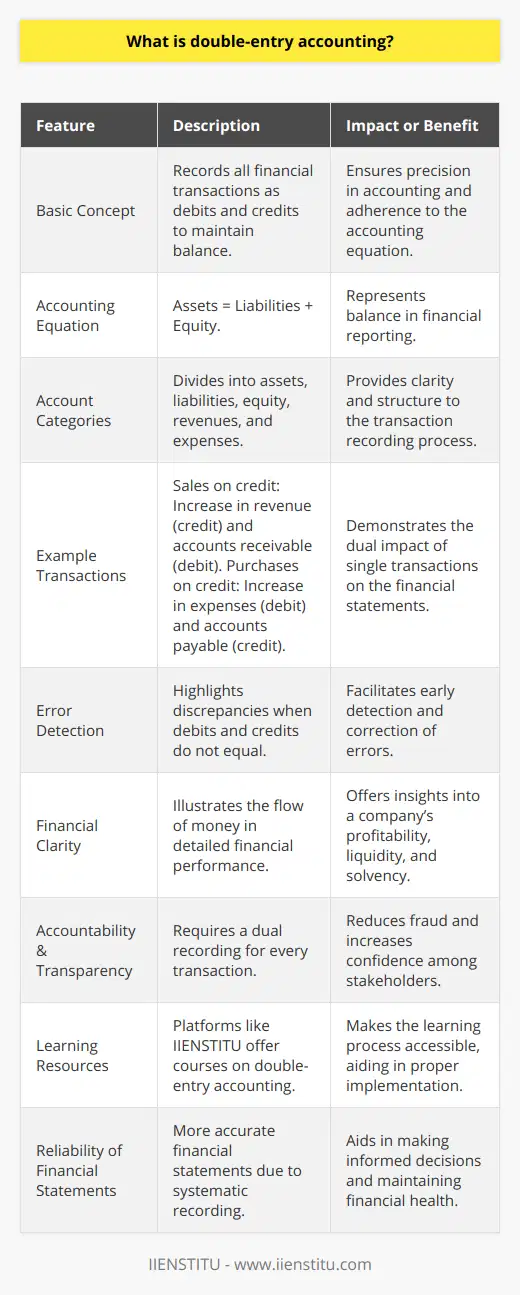
Why are closing entries and preparing financial statements important?
Closing entries and preparing financial statements are critical tasks when winding down operations or bankruptcy proceedings start. They help provide information to potential buyers or creditors, as well as give a clear picture of the company's overall financial standing.
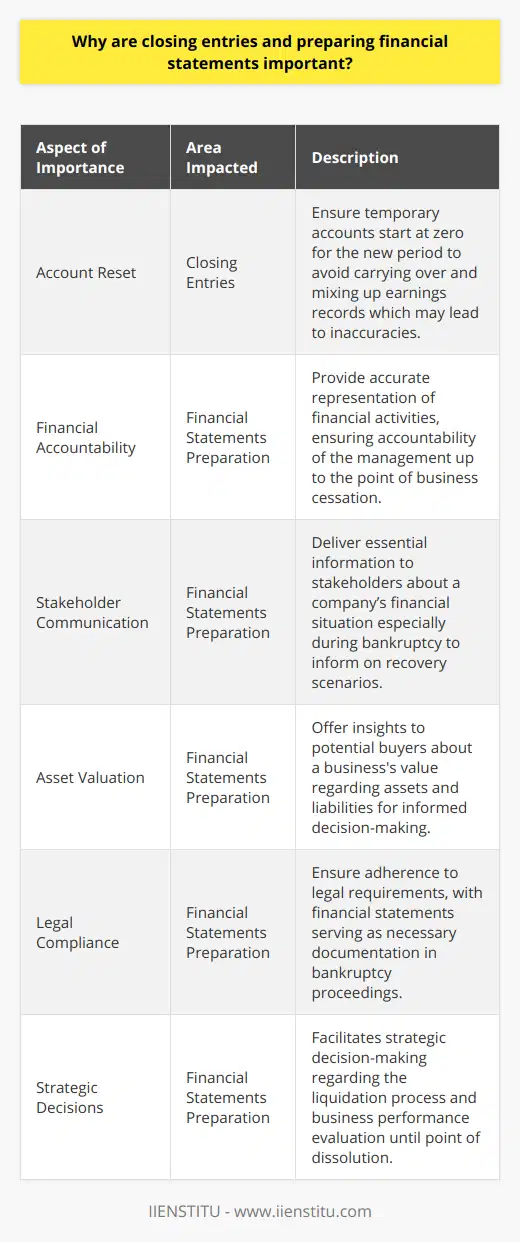
How can I stay on top of my business finances?
The most important thing is to be consistent and update your journal regularly. Additionally, double-entry accounting can be a great tool to help you better understand where your money is going and make more informed decisions. Finally, staying organized and creating deadlines for yourself can also be helpful in managing your business finances.

What are the key elements of financial accounting?
Assets: Assets are economic resources that a company owns or controls, such as cash, inventory, accounts receivable, buildings, machinery, and land.
Liabilities: Liabilities are amounts owed by the company to outsiders, such as accounts payable, wages, taxes, and interest payable.
Equity: Equity is the residual interest of the owners in the assets of the business after deducting all liabilities.
Revenues: Revenues are inflows of cash or other assets from the sale of goods and services.
Expenses: Expenses are outflows of cash or other assets used to produce goods and services.
Gains and Losses: Gains and losses are increases and decreases in the value of assets, liabilities, and equity that result from transactions or other events.
Financial Statements: Financial statements are the primary means of communication between a company and its stakeholders. Financial statements include the income statement, balance sheet, statement of cash flows, and statement of changes in equity.
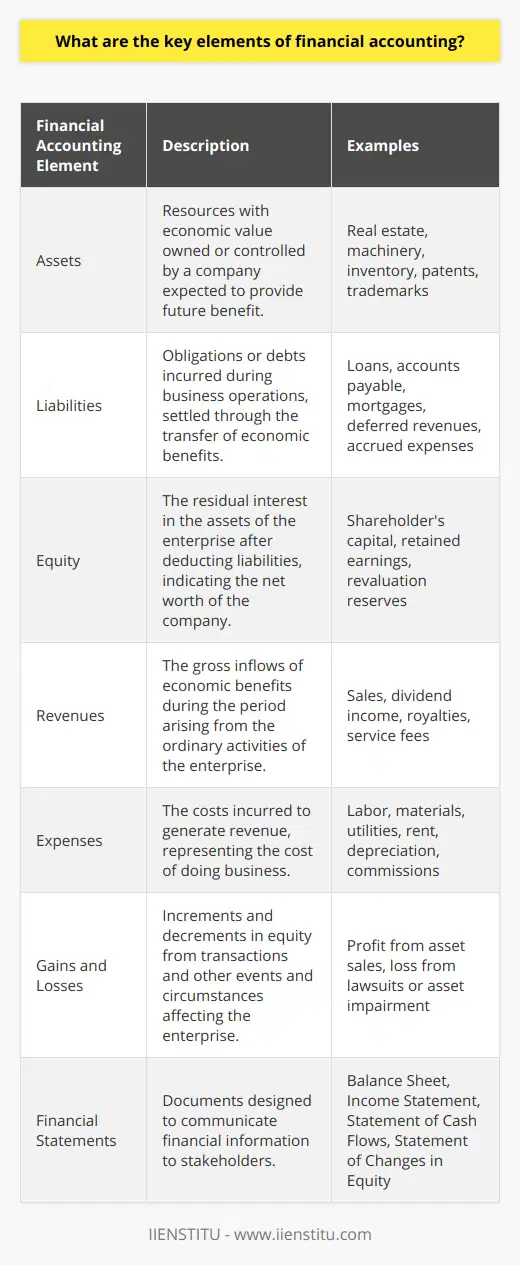
What methods can be used to ensure accurate financial reporting?
Have a system of internal controls.
Implement a “second set of eyes” policy.
Perform regular audits and reviews.
Utilize automated financial software.
Ensure proper segregation of duties.
Adopt a “zero tolerance” policy for errors.
Ensure supervisors are aware of financial policies and procedures.
Require employees to take appropriate training and certifications.
Monitor transactions and activities for any irregularities.
Engage an independent financial expert for guidance.
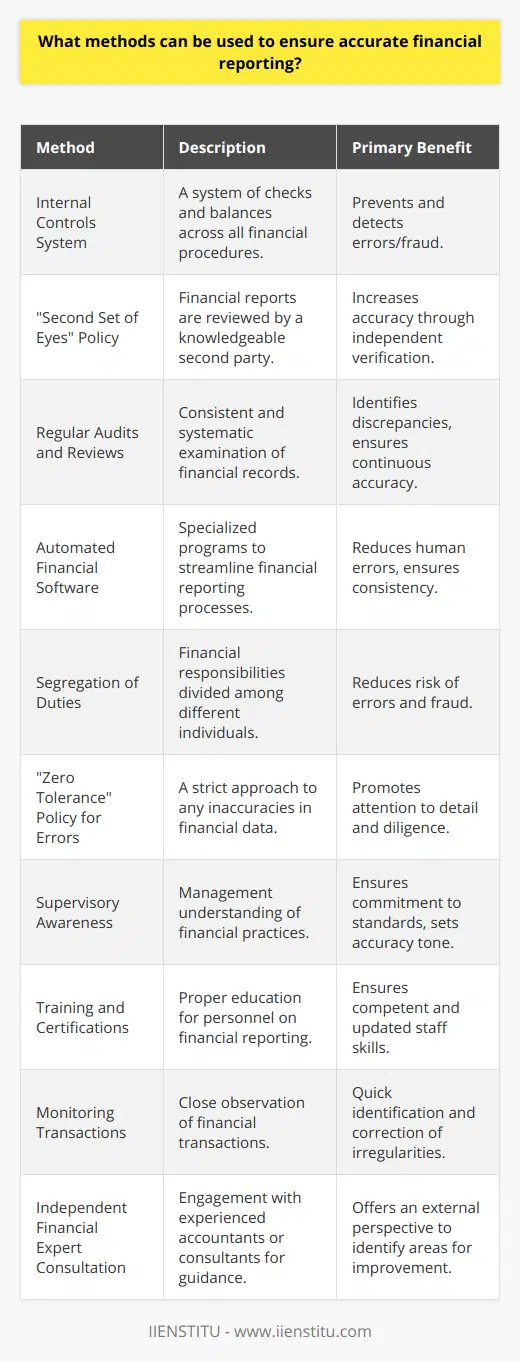
What are the best practices for maintaining financial records?
Separate personal and business finances.
Keep accurate and up-to-date records.
Establish a filing system for financial documents.
Create a budget and stick to it.
Reconcile bank statements regularly.
Monitor cash flow and track expenses.
Secure financial data with backup systems.
Regularly review financial statements.
Use financial software to automate data entry.
Consider hiring a professional accountant for help.
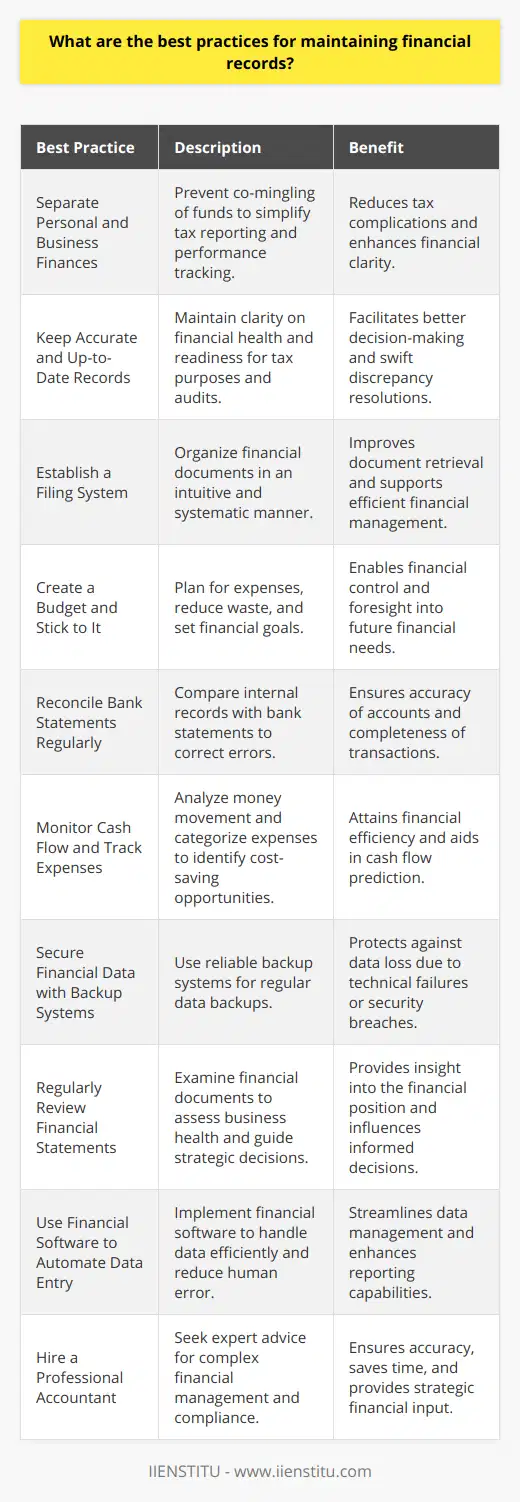
What are the 3 main objectives of accounting?
Overview of Accounting Objectives
Accounting is an essential aspect of managing a business and maintaining its financial integrity. The three main objectives of accounting are to provide information about a company's financial performance and position, facilitate decision-making, and ensure compliance with regulations and laws.
Financial Performance and Position
The first key objective of accounting is to measure and report a company's financial performance and position. This involves recording and analyzing financial transactions and events, preparing financial statements, and interpreting the results. By providing accurate and reliable information about a company's financial health, accounting allows for better understanding and assessment of its profitability, liquidity, solvency, and overall growth potential.
Facilitating Decision-Making
The second main objective of accounting is to provide relevant information that facilitates decision-making processes for various stakeholders, including management, investors, creditors, and regulators. Such information helps these groups make informed decisions about resource allocation, risk management, and strategic planning. For instance, management may use accounting data to determine the cost-effectiveness of different operations and investments, while investors and creditors may rely on the same data to evaluate a company's creditworthiness and potential returns on investment.
Ensuring Compliance and Accountability
Lastly, the third primary objective of accounting is to ensure compliance with relevant laws, regulations, and professional standards. Regulatory compliance is essential for maintaining public trust and preventing unethical or fraudulent activities that may harm a company's stakeholders. By following generally accepted accounting principles (GAAP) and adhering to standards set forth by professional bodies, such as the Financial Accounting Standards Board (FASB) and the International Accounting Standards Board (IASB), businesses can demonstrate their commitment to transparency, accuracy, and accountability.
Conclusion
Accounting is indispensable for any business to succeed, as it plays a significant role in monitoring financial performance, guiding decision-making, and ensuring compliance with applicable regulations. Understanding the three main objectives of accounting is crucial for business owners and managers in setting the right priorities and achieving corporate goals while preserving the company's credibility, reputation, and sustainability in today's challenging business environment.

What are the 5 objectives of accounting?
**Objective 1: Recording Financial Transactions**
The first objective of accounting is to systematically record financial transactions. This involves documenting all business transactions in a clear and organized manner, ensuring traceability and accountability.
**Objective 2: Reporting Financial Information**
Accounting aims to provide regular and accurate financial reports. These reports, including income statements, balance sheets, and cash flow statements, offer valuable insights into a business's financial position and overall performance.
**Objective 3: Ensuring Compliance with Regulations**
Adhering to laws and regulations is a vital objective of accounting. Compliance with applicable government guidelines, tax laws, and accounting standards ensures a company's financial practices remain legally acceptable and uphold its ethical reputation.
**Objective 4: Facilitating Decision-Making**
Accounting provides valuable information to decision-makers within an organization. With accurate financial data, management can identify trends, analyze performance, and create informed strategies to optimize the business's overall growth and profitability.
**Objective 5: Evaluating Financial Performance**
Lastly, accounting plays a significant role in evaluating a company's financial performance. By comparing financial data overtime, management can monitor the effectiveness of operational strategies, assess the efficiency of resource utilization, and determine areas for improvement.
In conclusion, the five objectives of accounting – recording financial transactions, reporting financial information, ensuring compliance with regulations, facilitating decision-making, and evaluating financial performance – contribute to the effective management and growth of a business. By prioritizing these objectives, organizations can maintain accurate financial records, comply with relevant laws and regulations, make data-driven decisions, and achieve long-term success.

What are the 4 general objectives of financial statements?
Overview of Financial Statements Objectives
The core intention of financial statements is to convey necessary financial information to its users - investors, creditors, regulators, and other stakeholders. There are four general objectives of financial statements, which are discussed below.
Assess Financial Performance
One of the key objectives of financial statements is to evaluate an entity's financial performance. Financial statements offer relevant data on revenues, expenses, and profits, enabling users to assess the organization's profitability and efficiency. Users can analyze trends, compare with competitors, and make informed decisions based on financial performance.
Evaluate Financial Position
Another objective is to evaluate a company's financial position, which involves analyzing its assets, liabilities, and equity. The balance sheet, one of the critical financial statements, presents a summary of the company's financial position. Users can determine the organization's solvency, liquidity, and capital structure, thereby gauging its ability to meet obligations and invest in future growth.
Monitor Cash Flow Activities
Financial statements serve the purpose of tracking the cash flow activities of a company. The statement of cash flows provides information on cash generated and utilized in operating, investing, and financing activities. Cash flow information helps users evaluate the firm's ability to generate cash, assess liquidity, and determine the feasibility of future expansion plans.
Ensure Accountability and Transparency
Lastly, financial statements aim to create accountability and improve transparency. By disclosing accurate and relevant information, financial statements ensure organizations are held accountable for their financial decisions. This transparency aids stakeholders in effectively monitoring and supervising the entity's financial affairs, promoting better governance and ethical conduct.

What are the primary functions and goals of financial accounting in an organization?
Accounting: The Lifeblood of a Business
Financial accounting serves as the lifeblood of a business. Its primary function involves recording and reporting financial transactions. This includes inventory purchases, sales revenues, costs, and operating expenses. These records assist in providing transparent insights about the company's financial health.
Data Analysis and Reporting
Accountants analyze this data and prepare financial statements. These financial statements, including income statements, balance sheets, and cash flow statements, allow for comprehensive reporting. This reporting attracts investors as it represents the company's solvency and profitability.
Decision-Making Aid
Furthermore, financial accounting aids decision-making. Directors analyze these financial documents when planning future action. They target company expansion, devise marketing strategies and make important financial decisions. It guides them in identifying cost-effective techniques, maximizing profit, and minimizing loss.
A Performance Evaluation Tool
Moreover, comparison is another essential function of accounting. By comparing current and past financial statements, accountants evaluate the organization's performance. It helps in recognizing growth trends and in identifying areas that need improvement.
Ensuring Regulatory Compliance
Financial accounting also ensures regulatory compliance. Businesses must comply with tax laws and accounting standards. Accountants handle such responsibilities, preparing tax returns and maintaining compliance with relevant accounting standards.
Record Maintenance for Future Reference
Maintenance of records is another crucial aspect. It aids in checking a company's financial history whenever required. Historical records come handy during audits, tax assessment or obtaining financial assistance.
In conclusion, financial accounting is pivotal for any organization. It aids in monitoring the financial health, ensures regulatory compliance, assists decision-making and maintains historical records. Thus, every organization must give due importance to financial accounting for running a successful enterprise. It not only ensures smooth running but also aids in sustainable development.
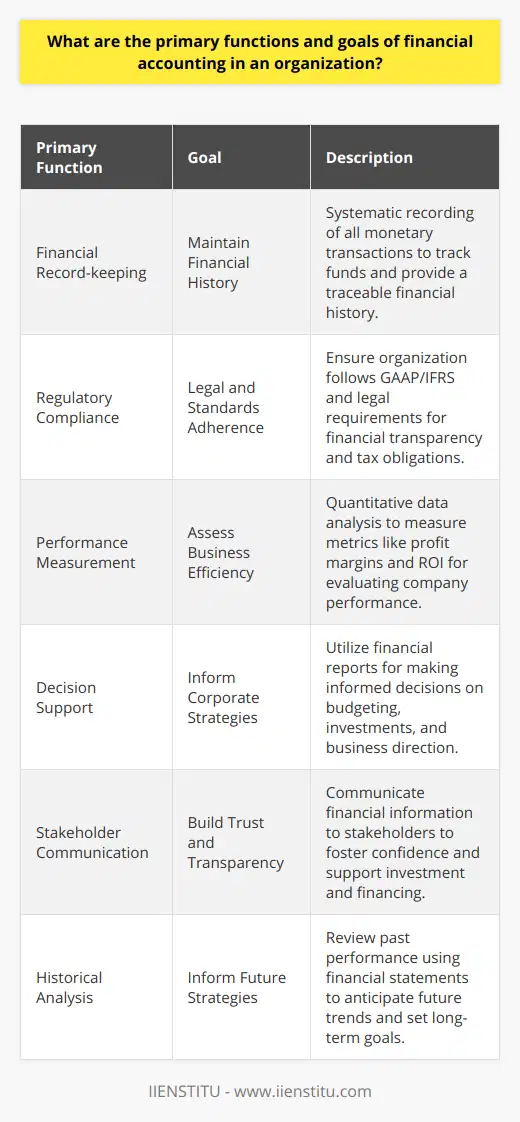
How do the various objectives of accounting contribute to decision-making processes and financial management within a company?
Contributing Factors
Accounting plays a vital role in providing essential information for decision-making processes and financial management within a business structure. Core objectives of accounting contribute significantly in multiple ways.
Data Accuracy and Reliability
First, accounting ensures data accuracy, which is pivotal for any decision-making process. Managers can rely on precise financial records when making crucial operational decisions. Accurate financial data eliminates approximations, improving overall decision quality.
Financial Performance
Secondly, accounting aids in understanding the financial performance of an organization. By observing financial statements, executives can identify areas needing improvement, which aids in strategic planning. Regular assessment of profit-and-loss statements can provide insights into the company’s profitability, guiding better financial management decisions.
Liability Management
Thirdly, accounting assists in managing liabilities. By providing an accurate account of debts, companies can manage repayments effectively. This assists in avoiding financial pitfalls, improving the company's financial health and stability.
Future Prediction
Lastly, accounting helps in predicting future trends. Past financial data can be vital for forecasting the organization's financial trajectory. This prediction aids when planning the allocation of resources and setting budgets, contributing to strong financial management.
In conclusion, accounting objectives are significantly intertwined with decision-making processes and financial management. They ensure data accuracy, access to past and present financial performance, and assists in liability management and future trend predictions. All of these factors enable better decisions and contribute to overall business success.

In what ways do the principles and objectives of accounting align with regulatory requirements, ethical considerations, and transparency for stakeholders?
Alignment with Regulatory Requirements
The principles of accounting, including consistency, relevance, and reliability, directly align with existing regulatory requirements. They necessitate accurate record-keeping, discourage fraud, and ensure accountability. Consistent application of these accounting principles can meet regulatory mandates and curb unethical practices.
Ethical Considerations in Accounting
Moreover, the objectives of accounting, which involve providing unbiased financial information, integrate ethical considerations. They call for transparency, integrity, and objectivity in financial reporting. These ethical benchmarks prevent discrepancies, manipulations, and bias in accounting practices.
Promoting Transparency for Stakeholders
Accounting’s commitment to truth and accuracy aligns with the duty of transparency to stakeholders. The stakeholders rely on the given financial information for investment and strategic decisions. Therefore, false or misleading entries violate both accounting’s principles and stakeholders' interests.
Thereby, accounting strives for harmonious alignment between its principles, objectives and the demands of regulatory, ethical and transparency requirements. Clear, unbiased reporting can improve stakeholder trust and promote adherence to ethical standards and regulatory guidelines.The interplay between these elements in accounting sheds light on its pivotal role in maintaining financial decorum and strengthening corporate governance. Thus, the practice of accounting is not just about numbers, but it symbolizes judicious resource management, ethical responsibility, and stakeholder transparency.
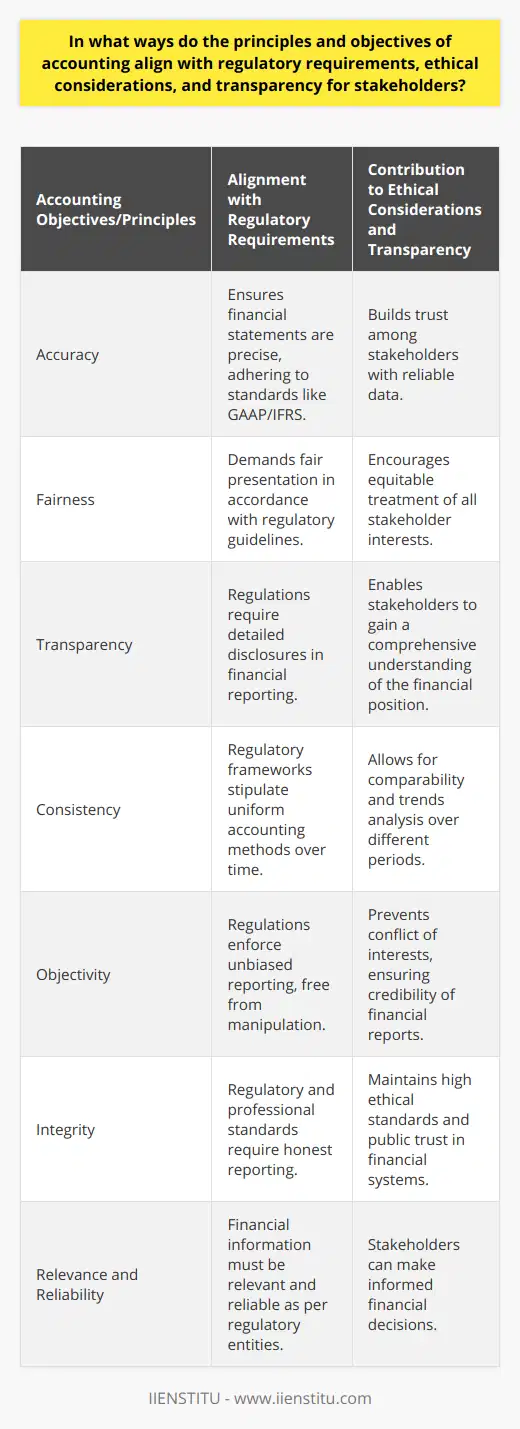
What are the four main objectives of accounting?
Accounting Objectives: An Overview
Accounting aims to systematically record, interpret, and communicate financial information. As a critical component of effective business management, accounting carries four main objectives.
Measurement of Financial Performance
The first objective refers to the measurement of financial performance. This involves tracking revenues and expenditures to determine profitability. Regular performance evaluations help to highlight trends, revealing areas for improvement, thereby enhancing overall financial health.
Control of Organizational Operations
Another objective involves control of organizational operations. Accounting allows businesses to exercise management control systems. This includes budgeting and forecasting practices that can prevent malfeasance, improve efficiency, and assist in setting financial targets.
Protection of Business Assets
Accounting also aids in the protection of business assets. Proper accounting habits deter and detect frauds, thefts, and errors. Consequently, this promotes accountability, secures assets, and ensures the reliable allocation of resources.
Effective Decision-Making
The fourth objective facilitates effective decision-making. Detailed financial reports provide insights into a company's financial position. Thus, management can make data-driven decisions, such as investing in new business ventures, setting competitive prices, and developing strategic plans.
In conclusion, accounting aims to measure performance, control operations, protect assets, and facilitate decision-making. Therefore, it plays a central role in fostering sustainable business growth.
Thus, mastering accounting objectives is crucial for any business, large or small. The success of a company may indeed significantly hinge on the effectiveness of its accounting systems and practices.

How do the six objectives of accounting support effective financial planning and resource allocation within an organization?
Understanding Financial Health
The six objectives of accounting directly provide comprehensive information that aids effective financial planning. They offer an accurate reflection of a firm's monetary state, informing decisions regarding resource allocation.
Maintaining Records
Firstly, accounting objectives guide the systematic recording of financial transactions. This detailed documentation enables organizations to plan their spending efficiently, accounting for every financial activity occurring within a business.
Calculating Profit and Loss
Secondly, accounting shows a company's profitability. Calculating profit or loss accurately provides a framework for organizations to devise their spending and saving strategies, bolstering financial planning.
Assessing Financial Position
Thirdly, determining the financial position of a company is of prime importance. An organization's balance sheet serves as an analytic tool guiding the allocation of resources, planning investment decisions, and capital budgeting.
Providing Information to Stakeholders
Fourthly, sharing information with interested parties is crucial. Reliable and transparent accounting data supports stakeholders in making informed decisions about investing or lending to a company, establishing trust and aiding in sustainable financial planning.
Assisting in Decision-Making
Moreover, accounting information aids in vital decision-making processes. It offers analytical insights that enable organizations to devise long-term strategies, aiding in effective resource allocation.
Regulatory Compliance
Lastly, ensuring regulatory compliance is a fundamental objective. Adherence to financial laws and standards safeguards organizations against legal complications, providing a sound basis for both financial planning and resource allocation.
In conclusion, the six objectives of accounting collectively enhance an organization's financial planning and resource allocation by delivering accuracy, transparency, and insightful analyses of a company's financial health.
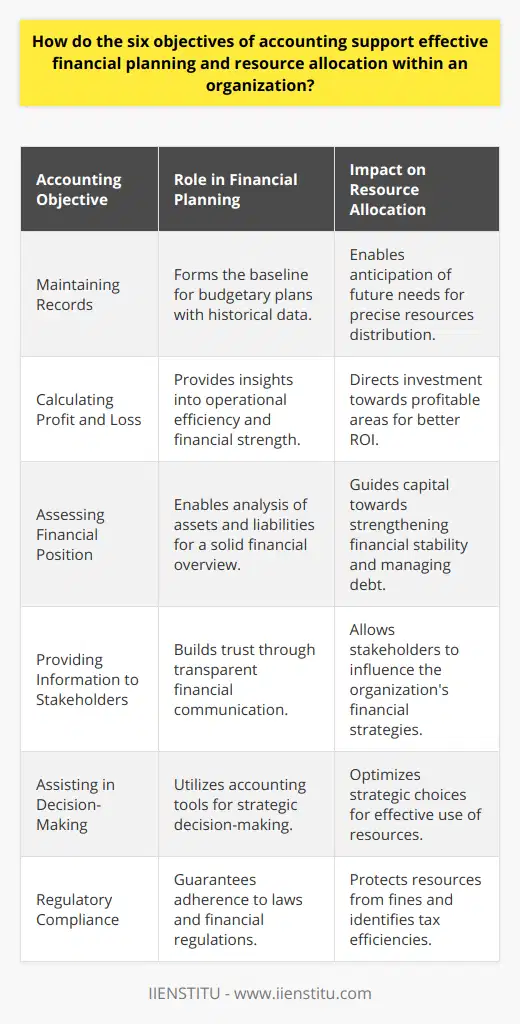
How do the different objectives of financial accounting ensure compliance with regulatory standards and facilitate communication among various stakeholders?
Financial Accounting Objectives and Regulatory Compliance
Financial accounting's primary purpose is to offer accurate and timely information to stakeholders. This responsibility implies that financial accounting must adhere to regulatory standards. Regulatory standards, such as Generally Accepted Accounting Principles (GAAP) or International Financial Reporting Standards (IFRS), ensure that businesses maintain honest, clear, and consistent records.
Adherence to these standards not only legitimizes a business's financial statements but also facilitates regulatory compliance. Consistent regulatory compliance results in enhanced business credibility, easing potential regulatory penalties. Thus, one of financial accounting's most crucial roles is ensuring regulatory standards compliance.
Enhancing Communication among Stakeholders
Another core objective of financial accounting is to facilitate communication among various stakeholders. Stakeholders include investors, employees, customers, suppliers, and the government. They require relevant financial information to make knowledgeable decisions regarding the company.
Financial accounting ensures that stakeholders receive timely, accurate, and consistent financial information. This information enables them to evaluate the company's financial position, performance, and changes in financial position. The provision of such information helps stakeholders understand a company's financial health, thus enhancing communication.
Financial Statements as a Communication Tool
Lastly, financial accounting produces financial statements that serve as significant communication tools. These financial statements include the balance sheet, income statement, cash flow statement, and statement of shareholders' equity. Each statement communicates different financial aspects that stakeholders use to make informed decisions about the firm.
In conclusion, financial accounting's different objectives ensure compliance with regulatory standards and facilitate communication among stakeholders. Following regulatory standards enhances credibility while providing accurate financial information strengthens communication. Therefore, financial accounting plays a critical role in both ensuring compliance and enhancing stakeholder communication.
